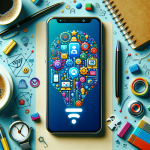
On-Device AI: Smarter Phones in 2025
On-Device AI: Smarter Phones in 2025
The year 2025 is set to usher in a new era for smartphones, with on-device AI leading the charge toward privacy-friendly and faster mobile computing. This tutorial explores the transformative shifts in smartphone technology, particularly focusing on the integration of AI algorithms that operate directly on devices, reducing the need for cloud interaction.
Prerequisites
- Basic understanding of smartphone technology
- Interest in AI and machine learning concepts
- Familiarity with mobile apps and operating systems
What is On-Device AI?
On-device AI refers to artificial intelligence systems that process data locally on a device, rather than relying predominantly on cloud services. This shift is driven by the need for enhanced privacy, reduced latency, and improved performance in smartphone applications.
Benefits of On-Device AI
- Improved Privacy: Sensitive data is processed locally, minimizing the risk of exposure during data transfer.
- Faster Performance: By handling computations on the device, AI features can operate in real time, enhancing user experiences.
- Data Efficiency: Local processing reduces the need for constant internet connectivity, allowing users to enjoy functionalities even in low-signal areas.
The Evolution of Smartphone AI
Over the past few years, smartphones have gradually integrated AI functionalities, from voice assistants to camera enhancements. In 2025, this evolution is expected to peak with advancements, including:
- Personalized User Experiences: AI will analyze user behavior to customize interfaces and suggestions, making interactions more intuitive.
- Edge Computing: On-device AI eliminates reliance on cloud servers, providing faster data processing and reducing latencies caused by network delays.
- Real-time Analytics: Featuring AI-powered applications will lead smartphone functionalities to adapt and respond to user habits in real-time.
How On-Device AI is Built
The architecture of on-device AI in smartphones typically includes:
- Machine Learning Algorithms: These algorithms analyze massive datasets to learn user preferences and behavior patterns.
- Neural Processing Units (NPUs): Specialized hardware in modern smartphones that enhances the speed and efficiency of AI processing tasks.
- Local Data Storage: Data is stored on-device for quick access and processing, ensuring that user data remains secure.
Challenges of On-Device AI
Despite its benefits, on-device AI comes with challenges that need to be addressed:
- Resource Limitation: Smartphones have finite processing power and battery life that can limit complex AI calculations.
- Development Complexity: Building effective machine learning models that can operate efficiently on smaller devices requires skilled expertise.
- Security Concerns: Although local processing offers privacy, it still must be safeguarded against potential local threats.
Future of On-Device AI in Smartphones
In the coming years, developers will need to focus on optimizing AI algorithms to efficiently utilize the limited resources of smartphones. Strategies may involve:
- Creating lightweight models that require less computation power.
- Implementing advanced security protocols to protect data.
- Fostering collaboration among hardware manufacturers and software developers to enhance device capabilities.
Summary Checklist
- Understand the principles of on-device AI.
- Explore the benefits and challenges associated with it.
- Stay updated on emerging technologies and AI advancements.
- Consider privacy and data security when using smartphone AI features.
For further insights into how AI is changing mobile technology, check our article on Mastering Edge AI: Smooth User Experience.














